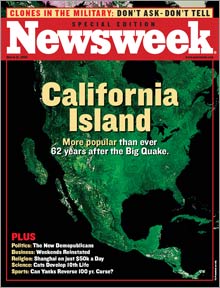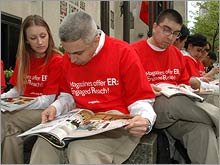 |
| A fake magazine cover used to promote the industry. The date is March 2095. The subject: the island of California, 62 years after an earthquake. |
|
 |
| As part of a magazine promotion last month, actors thumbed through magazines near NBC's studios in New York City. The t-shirts were a pun on the network's hit drama "ER." |
|
|
|
NEW YORK (CNN/Money) -
The radio industry, whose main goal is not to entertain but to help companies build consumer awareness through advertising, has discovered it's got an image problem -- and it's fighting back.
Facing sluggish growth and the perception that traditional radio is on the decline, AM-FM radio operators are banding together in ways that once were improbable.
On Tuesday a radio industry group released the findings of a new study purporting to show that a 30-second radio spot promises advertisers a far better return on investment than a 30-second television commercial.
While TV executives will likely dismiss the claims as flawed, the study is remarkable for another reason: it's the product of a $5 million-a-year, industry-funded research group whose mission is to help radio station owners combat the growing popularity of subscription-based satellite radio and the iPod portable music player, among other competitive new technologies.
The fact that the research firm even exists is a sign of how times have changed for the lumbering AM-FM radio industry, which is expected to see advertising dollars grow just 2 to 4 percent in 2005. Its backers include the country's two largest radio operators, Clear Channel (Research) and Infinity Broadcasting, owned by Viacom (Research).
"The industry used to compete with itself," said Gary Fries, the president of the Radio Advertising Bureau and co-chairman of the research group, the Radio Ad Effectiveness Lab.
Today radio station owners recognize that their main threats are external. "Now they're trying to make sure they all have a seat at the (advertisers') table," said Fries.
Magazines: it's hip to be square
Other traditional media at risk of being drowned out by the din over the Internet and television are suddenly looking a lot scrappier.
Magazine publishers, still not fully recovered from a severe slump in 2001, have signed off on a three-year, $40 million marketing campaign that is a first for their fiercely competitive industry.
Last month the magazines boldly crashed a major TV party: the annual "upfront" in New York during which networks present their fall lineups and fete advertisers.
As ad execs arrived to watch ABC showcase its coming shows in the hopes of luring advertisers, they were greeted by groups of magazine reps in bright-colored T-shirts blaring "We'd be LOST without our magazines" and "We're DESPERATE for our magazines" -- puns on ABC hits "Desperate Housewives" and "Lost."
And the magazine industry ran ads in The New York Times, The Wall Street Journal and various trade publications earlier this year using fake magazine covers to convey the message that the industry is here to stay.
Nina Link, president of the Magazine Publishers of America, the industry group running the marketing campaign, said a joint effort of this magnitude is new to the magazine world. "In terms of scale, this is huge," she said. "It is a very, very important step of an industry that has been very competitive."
Newspapers look for a common language
Several years ago the actress Meryl Streep and singer LL Cool J touted the virtues of newspaper reading in industry-sponsored ads similar to the milk industry's famous "Got Milk?" campaign.
Today, newspaper publishers think much more needs to be done. They're battling competition from the Internet, a circulation scandal, and the perception that they're stodgy and unappealing to young readers.
To address these threats, publishers are gearing up for a major ad campaign starting this fall, said John Kimball, chief marketing officer of the Newspaper Association of America.
A centerpiece of the effort: for the first time, a single message that newspaper sales teams can take to advertisers.
"How powerful would it be if all of the presentations being made by thousands of advertising sales people at newspapers across the country were all talking about the medium using the same words, the same data, and describing us in the same way?" said Kimball. "We think it could make difference."
Newspaper publishers are also planning an ad campaign for next year and to find a way to convince advertisers to look past current circulation measures, which they don't believe accurately reflect how many people read newspapers
"We want to surprise the advertising industry with the facts and truth about newspapers," said Kimball. He declined to estimate the costs of the campaign, but said direct expenses would come directly out of his budget.
Looking for the payoff
To be sure, newspapers, radio and magazines still control roughly half of the $180 billion-plus U.S. advertising market. But their growth rates are among the slowest of all major media, causing concerns that they will lose out to the faster-growing Internet and cable television in the long run.
Kimball and his radio and magazine counterparts see the image makeovers as a way to shed their industries' reputation for stodginess and to refute the impression that their industries are doomed by new technologies.
Radio, for instance, is touting its move toward high-definition radio. The industry is also embracing a popular new practice called "podcasting," in which users can download popular radio shows onto their computer hard drives or a portable device.
Newspaper and magazine publishers are looking to tap digital technologies for new revenues streams, including providing content to cell phones and other wireless devices.
Newspapers, criticized for failing to see the revenue potential of online job searches and other forms of classified advertising, are taking business risks now that they never did before, said Kimball.
Changing perceptions will take time and money, said Link of Magazine Publishers of America. But she thinks the image makeover will work.
"I think it's a time of great transition and a time of great opportunity," she said.
For more on large-cap companies making news, click here.

|